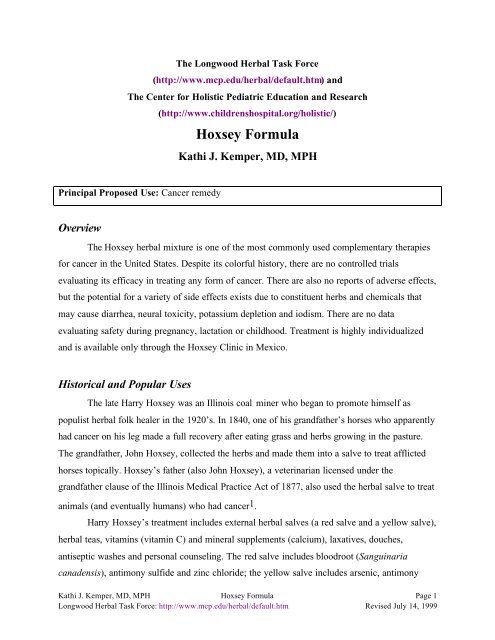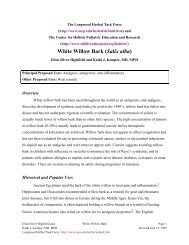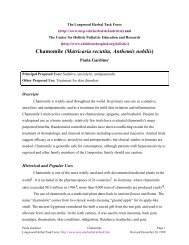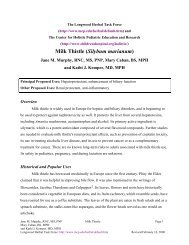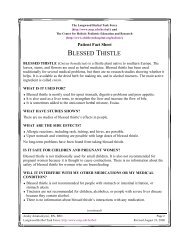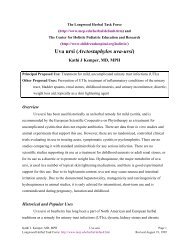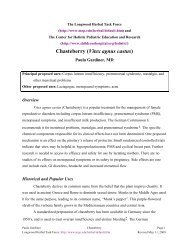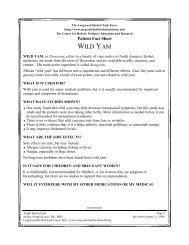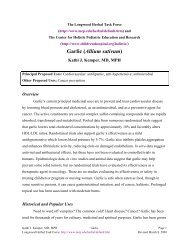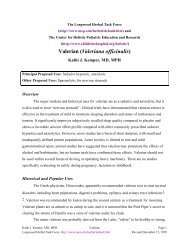Hoxsey Formula - Longwood Herbal Task Force
Hoxsey Formula - Longwood Herbal Task Force
Hoxsey Formula - Longwood Herbal Task Force
Create successful ePaper yourself
Turn your PDF publications into a flip-book with our unique Google optimized e-Paper software.
The <strong>Longwood</strong> <strong>Herbal</strong> <strong>Task</strong> <strong>Force</strong><br />
(http://www.mcp.edu/herbal/default.htm) and<br />
The Center for Holistic Pediatric Education and Research<br />
Principal Proposed Use: Cancer remedy<br />
Overview<br />
(http://www.childrenshospital.org/holistic/)<br />
<strong>Hoxsey</strong> <strong>Formula</strong><br />
Kathi J. Kemper, MD, MPH<br />
The <strong>Hoxsey</strong> herbal mixture is one of the most commonly used complementary therapies<br />
for cancer in the United States. Despite its colorful history, there are no controlled trials<br />
evaluating its efficacy in treating any form of cancer. There are also no reports of adverse effects,<br />
but the potential for a variety of side effects exists due to constituent herbs and chemicals that<br />
may cause diarrhea, neural toxicity, potassium depletion and iodism. There are no data<br />
evaluating safety during pregnancy, lactation or childhood. Treatment is highly individualized<br />
and is available only through the <strong>Hoxsey</strong> Clinic in Mexico.<br />
Historical and Popular Uses<br />
The late Harry <strong>Hoxsey</strong> was an Illinois coal miner who began to promote himself as<br />
populist herbal folk healer in the 1920’s. In 1840, one of his grandfather’s horses who apparently<br />
had cancer on his leg made a full recovery after eating grass and herbs growing in the pasture.<br />
The grandfather, John <strong>Hoxsey</strong>, collected the herbs and made them into a salve to treat afflicted<br />
horses topically. <strong>Hoxsey</strong>’s father (also John <strong>Hoxsey</strong>), a veterinarian licensed under the<br />
grandfather clause of the Illinois Medical Practice Act of 1877, also used the herbal salve to treat<br />
animals (and eventually humans) who had cancer 1 .<br />
Harry <strong>Hoxsey</strong>’s treatment includes external herbal salves (a red salve and a yellow salve),<br />
herbal teas, vitamins (vitamin C) and mineral supplements (calcium), laxatives, douches,<br />
antiseptic washes and personal counseling. The red salve includes bloodroot (Sanguinaria<br />
canadensis), antimony sulfide and zinc chloride; the yellow salve includes arsenic, antimony<br />
Kathi J. Kemper, MD, MPH <strong>Hoxsey</strong> <strong>Formula</strong> Page 1<br />
<strong>Longwood</strong> <strong>Herbal</strong> <strong>Task</strong> <strong>Force</strong>: http://www.mcp.edu/herbal/default.htm Revised July 14, 1999
sulfide, talc and sulfur. The internal tonic consists of cascara (Rhamnus purshiana) and one or<br />
more of the following: potassium iodide, red clover blossoms (Trifolium pratense), buckthorn<br />
bark (Rhamnus frangula), burdock root (Arctium lappa), barberry or berberis root (Berberis<br />
vulgaris), licorice root (Glycyrrhiza glabra), poke berries and root (Phytolacca americana),<br />
Queens root or stillingia root (Stillingia sylvatica) and prickly ash bark (Zanthoxylum<br />
americanum). <strong>Hoxsey</strong> advised patients to avoid consuming tomatoes, alcohol, processed flour<br />
and vinegar to avoid negating the formula’s effects.<br />
The chain of 17 clinics that <strong>Hoxsey</strong> ran in Texas in the 1930’s and 1940’s have all closed.<br />
The <strong>Hoxsey</strong> Clinic in Tijuana, Mexico is the chief facility providing <strong>Hoxsey</strong> treatment today<br />
(BioMedical Center, PO Box 727, 615 General Ferreira, Colonia Juarez, Tijuana, Mexico).<br />
Botany<br />
Medicinal species: Multiple species as above. The precise amounts of individual ingredients vary<br />
for each patient and are a proprietary secret.<br />
Common names: <strong>Hoxsey</strong> formula<br />
Botanical family: See individual monographs for specific herbs<br />
Plant description: See individual monographs for specific herbs<br />
Where it’s grown: All of the ingredients grow easily in North America.<br />
Biochemistry<br />
<strong>Hoxsey</strong> <strong>Formula</strong>: Potentially Active Chemical Constituents<br />
The herbal mixture is a unique, proprietary secret for each individual and may contain<br />
varying amounts of active chemical constituents. Several key ingredients in the tonic are<br />
potent cathartics. See individual monographs for specific biochemical ingredients.<br />
Kathi J. Kemper, MD, MPH <strong>Hoxsey</strong> <strong>Formula</strong> Page 2<br />
<strong>Longwood</strong> <strong>Herbal</strong> <strong>Task</strong> <strong>Force</strong>: http://www.mcp.edu/herbal/default.htm Revised July 14, 1999
Experimental Studies<br />
1. Cardiovascular: N/A<br />
2. Pulmonary: N/A<br />
3. Renal and electrolyte balance: N/A<br />
4. Gastrointestinal/hepatic: N/A<br />
5. Neuro-psychiatric: N/A<br />
6. Endocrine: N/A<br />
7. Hematologic: N/A<br />
8. Rheumatologic: N/A<br />
9. Reproductive: N/A<br />
10. Immune modulation: N/A<br />
11. Antimicrobial: N/A<br />
12. Antineoplastic: Antineoplastic<br />
13. Antioxidant: N/A<br />
14. Skin and mucus membranes: N/A<br />
15. Other/miscellaneous: N/A<br />
<strong>Hoxsey</strong> <strong>Formula</strong>: Potential Clinical Benefits<br />
Because the <strong>Hoxsey</strong> formula is used primarily as a cancer remedy, this review focuses on studies<br />
of the herbal mixture’s effect on cancer. See individual monographs for discussions of the effects<br />
of individual herbal components on other body systems.<br />
12. Antineoplastic: Antineoplastic<br />
i. In vitro data: None<br />
ii. Animal data: None aside from historical anecdotes<br />
iii. Human data: Anecdotal reports claim miraculous cancer cures from the <strong>Hoxsey</strong><br />
treatment. However, many of the patients who claimed to be cured had diagnosed<br />
themselves and did not have biopsy proven cancer, had been treated with conventional<br />
therapies as well as the <strong>Hoxsey</strong> formula, still had cancer even after the treatment, or had<br />
died 2 .<br />
Kathi J. Kemper, MD, MPH <strong>Hoxsey</strong> <strong>Formula</strong> Page 3<br />
<strong>Longwood</strong> <strong>Herbal</strong> <strong>Task</strong> <strong>Force</strong>: http://www.mcp.edu/herbal/default.htm Revised July 14, 1999
In a cohort study of 39 cancer patients treated at the Mexican Biomedical Center<br />
(<strong>Hoxsey</strong> Clinic), 23 were lost to follow-up within four years; of the remaining 16<br />
patients, 10 had died with an average survival time of 15.4 months. There were six<br />
survivors with an average survival time of 58 months: two had lung cancer (type and<br />
stage unspecified), two had melanoma, one had bladder cancer and one had labial cancer<br />
(stage unspecified). The investigators contacted patients directly and did not review<br />
medical records or perform physical examinations or laboratory tests 3 .<br />
No controlled trials have evaluated the safety or efficacy of the <strong>Hoxsey</strong> formula.<br />
Kathi J. Kemper, MD, MPH <strong>Hoxsey</strong> <strong>Formula</strong> Page 4<br />
<strong>Longwood</strong> <strong>Herbal</strong> <strong>Task</strong> <strong>Force</strong>: http://www.mcp.edu/herbal/default.htm Revised July 14, 1999
Toxicity and Contraindications<br />
All herbal products carry the potential for contamination with other herbal products, pesticides,<br />
herbicides, heavy metals and pharmaceuticals.<br />
Allergic reactions can occur to any natural product in sensitive persons.<br />
Allergic reactions: Contact dermatitis from burdock root has been reported.<br />
Potentially toxic compounds in the <strong>Hoxsey</strong> formula: Pokeweed is generally considered toxic and<br />
may cause death due to respiratory paralysis. Buckthorn and cascara can cause severe<br />
diarrhea, dehydration and potassium depletion. No acute adverse effects of the <strong>Hoxsey</strong><br />
formula have been reported.<br />
Acute toxicity: Burdock root, one of the <strong>Hoxsey</strong> formula’s constituents, may be contaminated<br />
with another species that can cause acute atropine-like poisoning. No acute toxicity of the<br />
<strong>Hoxsey</strong> formula itself has been reported.<br />
Chronic toxicity: Due to its cathartic effects, <strong>Hoxsey</strong>’s tonic may deplete serum potassium,<br />
thereby potentiating effects of cardiac glycosides; prudence suggests limiting chronic use<br />
or closely monitoring renal function and electrolytes. The potential for heavy metal<br />
toxicity exists from the external pastes containing antimony and arsenic. No adverse<br />
effects have been reported.<br />
Limitations during other illnesses or in patients with specific organ dysfunction: Due to iodide<br />
from potassium iodide, <strong>Hoxsey</strong> tonics should be used with caution in patients who may<br />
be sensitive to it.<br />
Interactions with other herbs or pharmaceuticals: Due to potential potassium depletion, avoid<br />
use by patients taking cardiac glycosides.<br />
Safety during pregnancy and/or childhood: Not generally recommended during pregnancy,<br />
lactation or childhood.<br />
Kathi J. Kemper, MD, MPH <strong>Hoxsey</strong> <strong>Formula</strong> Page 5<br />
<strong>Longwood</strong> <strong>Herbal</strong> <strong>Task</strong> <strong>Force</strong>: http://www.mcp.edu/herbal/default.htm Revised July 14, 1999
Typical Dosages<br />
Provision of dosage information dose NOT constitute a recommendation or endorsement, but<br />
rather indicates the range of doses commonly used in herbal practice. Doses may vary according<br />
to the type and severity of the condition treated and individual patient conditions.<br />
Typical adult doses: Unknown<br />
Pediatric dosages: Unknown<br />
Availability of standardized preparations: Unknown<br />
See Also:<br />
<strong>Hoxsey</strong> <strong>Formula</strong> Clinician Information Summary:<br />
http://www.mcp.edu/herbal/hoxsey/hoxsey.cis.pdf<br />
<strong>Hoxsey</strong> <strong>Formula</strong> Patient Fact Sheet: http://www.mcp.edu/herbal/hoxsey/hoxsey.ph.pdf<br />
University of Texas Center for Alternative Medicine Research in Cancer:<br />
http://www.sph.uth.tmc.edu:8052/utcam/agents/hoxsey.htm<br />
Kathi J. Kemper, MD, MPH <strong>Hoxsey</strong> <strong>Formula</strong> Page 6<br />
<strong>Longwood</strong> <strong>Herbal</strong> <strong>Task</strong> <strong>Force</strong>: http://www.mcp.edu/herbal/default.htm Revised July 14, 1999
REFERENCES<br />
1. Ward P. History of <strong>Hoxsey</strong> Treatment. Townsend Letter for Doctors 1997:68-72.<br />
2. Anonymous. Questionable methods of cancer management: 'nutritional' therapies. Cancer Forum 1994;<br />
18:28-33.<br />
3. Austin S, Baumgartner E, DeKadt S. Long term follow-up of cancer patients using Contreras, <strong>Hoxsey</strong> and<br />
Gerson therapies. Journal of Naturopathic Medicine 1995; 5:74-76.<br />
Kathi J. Kemper, MD, MPH <strong>Hoxsey</strong> <strong>Formula</strong> Page 7<br />
<strong>Longwood</strong> <strong>Herbal</strong> <strong>Task</strong> <strong>Force</strong>: http://www.mcp.edu/herbal/default.htm Revised July 14, 1999


